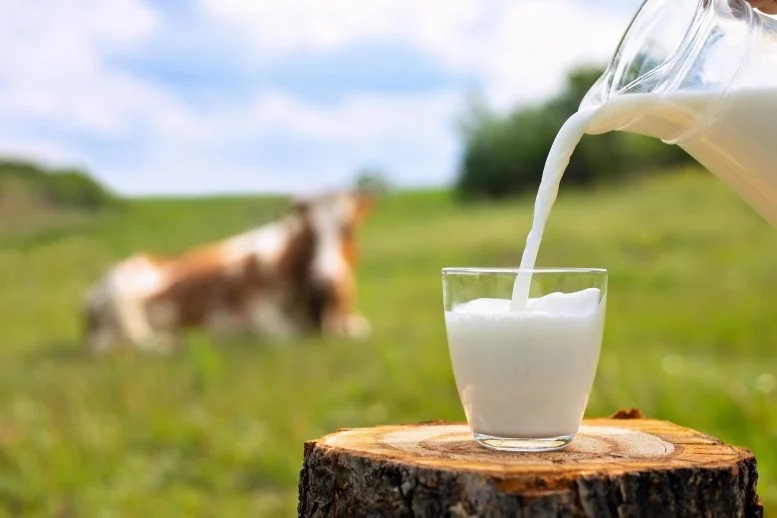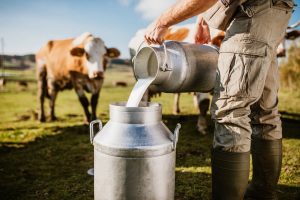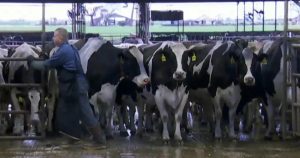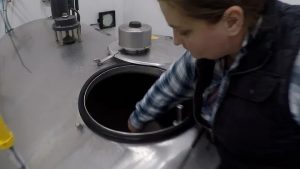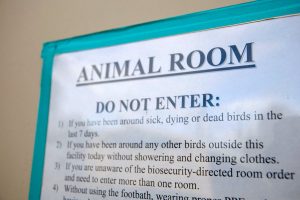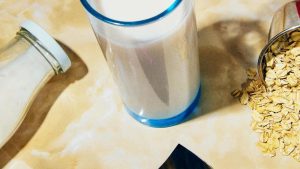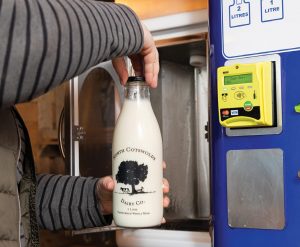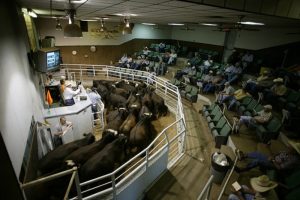
Most Americans don’t know bird flu is found only in raw milk, and many believe myths about its safety and health benefits.
In April 2024, the Food and Drug Administration (FDA) found the H5N1 bird flu virus in raw (unpasteurized) milk samples from four states. Bird flu has also been detected in raw milk being sold commercially. Despite these findings, many Americans are still unaware that drinking raw milk and eating products made from it carries significantly higher health risks than consuming pasteurized milk, especially for children.
Raw milk can carry harmful bacteria and viruses, including Salmonella, E. coli, Campylobacter, Cryptosporidium, Listeria, Brucella, and possibly H5N1 bird flu.
A recent survey by the Annenberg Public Policy Center (APPC) at the University of Pennsylvania found that while 56% of U.S. adults recognize that raw milk is less safe than pasteurized milk, more than 40% either aren’t sure (25%) or mistakenly believe raw milk is equally safe (12%) or even safer (6%). These results are nearly unchanged from a similar survey conducted in July 2024. Only 32% of respondents correctly said that raw milk increases the risk of foodborne illness, while 14% think it has no effect, and 51% are unsure.

The same survey, conducted from January 30 to February 10, 2025, with over 1,700 U.S. adults, also revealed that most people (66%) don’t know that children are more vulnerable than adults to getting sick from the pathogens found in raw milk.
Bird flu
As of March 10, 2025, 70 confirmed U.S. cases of H5 bird flu have been detected in people in 13 states, nearly all from exposure to infected poultry or dairy herds, according to the Centers for Disease Control and Prevention (CDC). One death from bird flu has been reported, involving a patient in Louisiana. To date, there have been no reported cases of human-to-human transmission.
From January 2022 through March 11, 2025, bird flu has been detected in nearly a thousand dairy herds in 17 states, and it has affected over 166 million poultry and wild aquatic birds, covering all states. Globally, according to the World Health Organization, from Jan. 1, 2003-Dec. 12, 2024, “954 cases of human infection with avian influenza A(H5N1) virus were reported from 24 countries. Of these 954 cases, 464 were fatal.”

Researchers have found that mice can be infected with bird flu by drinking raw milk. Although the FDA does not currently know whether H5N1 can be transmitted to humans through the consumption of raw milk, a study with mice suggests that the virus in “untreated milk can infect susceptible animals that consume it.” The National Institutes of Health says this suggests “that drinking raw milk may pose a risk of transmission to people.”
Raw milk and bird flu
Bird flu in raw milk: The vast majority of U.S. adults do not know that bird flu has been detected to date only in raw milk, not pasteurized milk. Just 17% know that bird flu has been found only in raw milk. Two percent incorrectly say bird flu has been found only in pasteurized milk, 7% say it has been found in both, 7% say it has been found in neither, and over two-thirds of those surveyed (68%) are not sure.
Raw milk and your chances of getting bird flu: Almost a quarter of people (22%) say drinking raw milk increases the chances you will get H5N1 or bird flu, up from 15% in July 2024, though this is unchanged from November 2024. An equal number (22%) say drinking raw milk has no effect one way or the other on whether you will get bird flu, though fewer people believe that today than in November 2024 (35%). Over half of those surveyed (53%) are not sure what effect drinking raw milk has on getting bird flu, up from 43% in November 2024.
The FDA has said that by heating milk to a specific temperature for a time, pasteurization kills harmful bacteria and viruses, and that pasteurization will inactivate the bird flu virus if it is present in raw milk.

Raw milk and health claims
APPC’s survey, which included non-milk drinkers, finds a small proportion of respondents (4%) who report having consumed raw or unpasteurized milk in the past 12 months, unchanged from our July 2024 survey. Another 2% were not sure whether they had consumed raw milk.
Survey respondents are equally split between those who say raw milk has more nutrients than pasteurized milk (28%) and those who say it has about the same amount of nutrients (28%). Forty percent are not sure. The FDA says pasteurization kills pathogens in raw milk “without any significant impact on milk nutritional quality.”
Promoters of raw milk have made many claims about its health benefits, but the FDA has categorized a number of them as misconceptions, as is explained here (current as of March 5, 2025). Though minorities believe in these claims, the survey finds that many more people – about half of U.S. adults or more – are not sure whether the claims are true or false:
- Bone thinning (osteoporosis): About 1 in 4 people (26%) believe that raw milk is “about as effective” as pasteurized milk at preventing osteoporosis, although 10% incorrectly believe raw milk is more effective and 59% are unsure. The FDA says raw milk is not more effective than pasteurized milk at preventing osteoporosis.
- Lactose intolerance: 40% believe that it is false to say that regularly consuming raw, unpasteurized milk cures lactose intolerance. But 10% incorrectly say this is true, and 50% are not sure. The FDA says raw milk does not cure lactose intolerance.
- Asthma: 39% believe it is false to say that regularly consuming raw milk reduces the symptoms of asthma, but 7% believe it is true, and 54% are not sure. The FDA says that raw milk does not cure or treat asthma and allergy.
- Immune system: 30% believe it is false to say that regularly consuming raw milk enhances the human immune system, but 23% think it is true, and 47% are not sure. The FDA says raw milk “is not an immune system building food and is particularly unsafe for children,” who are usually more vulnerable to pathogens in raw milk than adults.
- Children’s vulnerability to sickness: About a third (35%) know that children are typically more vulnerable than adults to getting sick from the viruses and bacteria that can occur in raw milk. But 5% incorrectly think they are less vulnerable, 16% think they are “about as vulnerable,” and 45% are not sure.
Government regulation of raw milk
The FDA has prohibited the interstate sale of raw milk since 1987, but 30 states in the United States allow its sale in some form, according to the FDA. Survey respondents were asked for their views on government regulation of raw milk sales and sellers:
Interstate raw milk sales: Nearly a quarter of those surveyed (24%) favor the interstate sale of raw milk, and a slightly larger group (28%) opposes it, statistically unchanged from September 2024. Nearly half of the respondents either are not sure (18%) or neither favor nor oppose it (29%).
Raw milk sales within a state: Nearly a quarter (24%) favor the unrestricted sale of raw milk in the state in which they live, and another quarter (25%) say the sale of raw milk should be banned, except for farmers selling from their own dairy herds on their own land. Fourteen percent say the sale of raw milk should be banned in their states, and 37% are not sure.

Government intrusion: Nearly a third (32%) agree that federal government regulations of raw unpasteurized milk are “another example of unnecessary government intrusion in people’s lives,” while a like number (34%) disagree. A third (33%) neither agree nor disagree.
The rights of raw milk sellers: A quarter (25%) agree that state laws prohibiting the sale of raw milk violate the constitutional rights of raw milk sellers, while a third (34%) disagree, and 41% neither agree nor disagree. (Asked of a random half-sample.)
Warning labels: Over half (56%) do not think that state laws requiring labels on raw milk containers warning about the risks of consuming raw milk violate the constitutional rights of raw milk sellers, while 14% think the state laws do violate their rights. Nearly a third (30%) neither agree nor disagree. (Asked of a random half-sample.)
USDA testing of raw milk: Asked in how many of the states the U.S. Department of Agriculture is testing raw milk for bird flu virus, 74% are not sure. Two percent say “none,” and a quarter of those surveyed say either “some” (10%), “most” (9%), or “all” (5%). As of Jan. 8, 2025, the USDA says its National Milk Testing Strategy has enrolled 28 states, accounting for nearly 65% of the nation’s milk production.
APPC’s Annenberg Science and Public Health Knowledge survey
The survey data come from the 23rd wave of a nationally representative panel of 1,716 U.S. adults conducted for the Annenberg Public Policy Center by SSRS, an independent market research company. Most have been empaneled since April 2021. To account for attrition, replenishment samples have been added over time using a random probability sampling design. The most recent replenishment, in September 2024, added 360 respondents to the sample. This wave of the Annenberg Science and Public Health Knowledge (ASAPH) survey was fielded Jan. 30-Feb. 10, 2025. The margin of sampling error (MOE) is ± 3.4 percentage points at the 95% confidence level. All figures are rounded to the nearest whole number and may not add to 100%. Combined subcategories may not add to totals in the topline and text due to rounding.
Download the topline and the methods report.
You can now read the most important #news on #eDairyNews #Whatsapp channels!!!
🇺🇸 eDairy News INGLÊS: https://whatsapp.com/channel/0029VaKsjzGDTkJyIN6hcP1K
